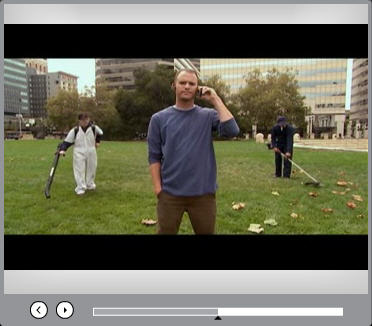A friend of mine got his start in marketing as a carnival pitchman. He would travel the country, selling electric blenders from a dusty demo booth. He was good. Really good. He once told me that a key to success on a highly competitive midway was being sure to gather a large crowd. In carny lingo this is called building a tip.
The web has replaced the carnival back lot. Search engines, online ads and other techniques do the job of building a tip. And once a visitor arrives at a site, today it’s often a video that gives the pitch.
I was blown away recently by just such an online pitch. It was for Jawbone, a noise-canceling Bluetooth cell phone earpiece. Below is a link to the site, where you can watch the full video:

If you’re like me, you were immediately sucked into the demo. That’s a key to a good pitch. Lead strong, without ever overdoing it and scaring your tip away. Here are three other things this video does right:
- Feature a pitchman (or woman) — Selling is always one-to-one, whether it’s to a throng of carnival revelers or to thousands of isolated web visitors. Similar to other direct sales media, such as direct mail, you cannot achieve record-breaking sales success online unless you are persistent in hammering away at the value of the product. A disembodied voice-over cannot make the necessary level of personal connection.
- Use drama — People buy things because it makes them feel good. There is pleasure in finding something that can improve a life. Whenever possible, illustrate dramatically how your product can do this. On the midway, my friend would chew up nuts and bolts in his blender. It was a loud, suspenseful, almost scary way to demonstrate power and durability. Then he’d replace the metal blender carafe for a glass one and cram it with fruits and vegetables — pits, stems and all. In what seemed like an instant he had made fruit smoothie samples for the audience, further showing the machine’s power and versatility. My friend made this device seem almost magical.
- Build to a strong finish — Selling is ultimately about theater. That means you should follow the same story arc most commonly used in entertainment. Bring your audience’s interest to a crescendo. Work their emotions until they cannot imagine what will happen next, and are hanging on every word and new development. Then make sure they understand that when your pitch ends, they are expected to take out their wallets. If you’ve done your job right, they will!
Ironically, last month I stumbled across this YouTube video. It’s for a high-powered blender, not unlike the kind my friend sold back in his pitchman days. This video breaks all of the rules of a good demo. I’m not surprised that one and only comment left at the bottom of the video reads as follows:
The Vitamix may be a good machine. But there is no way I’m paying $400 dollars for a stupid blender. I don’t care how good it is. If I had Bill Gates money I wouldn’t spend that much for a blender. I’m sure there’s a machine out there that’s just as good with a much nicer price. And I’m going to keep searching until I find it.
Ouch! Sorry, Vitamix. While showing all the tricks that this blender can perform, you failed to sufficiently build its value. You’d never survive a day on the midway.
